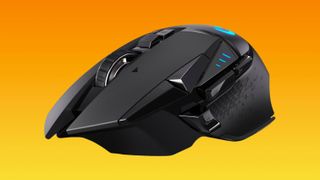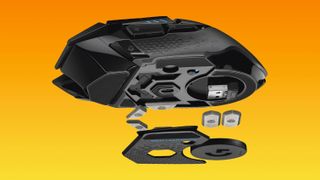Logitech G502 Lightspeed Review: The Top Gaming Mouse Goes Wireless
The Logitech G502 Lightspeed is still one of the best gaming mice ever made, but now it comes without any inconvenient wires.
Why you can trust Tom's Guide

I'll never forget the first time I saw the Logitech G502 Proteus Core. I had (and actually still have) a Logitech G500s at home, and I thought that with a few tweaks, it could be a perfect mouse. Then, I stumbled across the G502 and knew I was looking at something special. When I got my hands on it, I awarded it a perfect score and thought it'd be a long time before I saw another mouse as good.
That was five years ago, and since then, Logitech has done very little to tamper with the G502's winning formula. There's now RGB lighting, and you can often find the peripheral for $60 instead of its usual $80, but the mouse just didn't seem to need much else. In fact, I was surprised when Logitech contacted me and said the G502 was getting a big upgrade.
But the company wasn't kidding, because the Logitech G502 Lightspeed ($150, or less with one of our Logitech promo codes) is completely wireless — and it's also compatible with Logitech's inventive PowerPlay wireless-charging system ($100), if you're into that kind of thing. Everything that made the G502 wired variant work is still here, from the high-quality sensor, to the ergonomic design, to the inventive scroll-wheel options.
To be fair, the G502 Lightspeed falls just short of its predecessor's lofty example due to a high price, a few inconvenient design decisions and the cruel, relentless flow of time. (There are simply better mice on the market today than what the original G502 faced.) But if you've always wanted one of the best gaming mice ever made without the inconvenience of wires, the G502 Lightspeed is almost as good as they come.
Design
If you've used any of the previous iterations of the G502, then you already know what the G502 Lightspeed looks like. For the rest of you, it's a large (5.2 x 3.0 x 1.6 inches), right-handed, ergonomic mouse with a curved thumb rest and textured grips.
On the mouse's topside, you'll find a whopping 10 buttons. There's a right-click button, a left-click button and a clickable scroll wheel; right below that, there's a button that adjusts the scroll wheel's resistance. I've always found this feature extremely useful, since sometimes you want precision scrolling and sometimes you want to blast through a whole page in seconds.

Beneath that adjuster, there's a programmable button that, by default, checks the battery level. Off to the left side of the left-click button, there's a pair of dots-per-inch (DPI) sensitivity-adjustment buttons. On the side, there are two large thumb buttons, and just below them, there's a "sniper" button that can temporarily lower the DPI. This is admittedly a lot of buttons for a not-gigantic mouse, but they're laid out well and never feel too crowded.
The mouse gets considerably more interesting once you flip it over, though. That's where you'll find an on/off switch and a small, circular pop-out compartment. By default, this compartment stores the wireless dongle and can also store two optional 4-gram weights (more on this shortly). However, if you own the PowerPlay setup, you can also swap in the PowerPlay battery, which charges wirelessly as you play. This is a useful feature, although it does limit your weight options.

That brings us to tunable weights. Like the wired G502, the G502 Lightspeed has a removable panel where you can add metallic weights. The design isn't exactly the same as on the older mouse, since the G502 Lightspeed needs more room for wireless circuitry, but the result is the same.
I actually prefer the G502 Lightspeed's approach to weights; this mouse uses small, trapezoidal weights rather than the previous model's convoluted, semi-hexagonal models. Adding and removing weights is much easier than before, and there's still a little carrying case to store extra weights. It's a pain that you can't use the 4-gram weights and the PowerPlay attachment simultaneously, but this is an annoyance not a deal breaker.
MORE: Our Favorite Gaming Mice for Every Genre
I do, however, have one small criticism of the G502's design — which may actually be a point in the device's favor. The design hasn't changed at all in five years, which is admirable in a way. But since 2014, Logitech has launched two fantastic high-end wireless mice series: the Logitech G900 (currently the G903) and the Logitech G Pro Wireless, both of which also retail for $150 by default. Compared to the angular, bulky G502, both newer mice seem positively futuristic, with sleek curves and, in the G903's case, swappable parts to offer complete ambidexterity.
The G502's design still holds up extremely well, but for the same price, Logitech's other high-end wireless mice may feel a bit better to hold. Once I finished testing the G502, I went right back to the G903, and I haven't looked back.
Features
The G502 Lightspeed runs on the Logitech G Hub software, which lets users customize DPI (100-16,000), control backlighting and program all of the mouse's buttons. The software is pretty straightforward, and you can even program a secondary set of commands known as G-Shift. You'll have access to these whenever you hold down a button of your choice. (The sniper button is a good choice for this, in my experience, although I didn't use it too much in general.)

While you can indeed program the color of the G logo on the palm rest, that's just about the only part of the mouse that lights up. (The DPI monitor on the side lights up, too, but it's so small you'll hardly notice it.) While RGB features have never been the primary reason to buy or avoid a mouse, this one is going to look plain black most of the time. So bear that in mind if you're all about aesthetics.
The wireless performance was flawless in my experience, whether I was deep into a gaming session or simply surfing the web.
Naturally, the G502 Lightspeed's most important feature is the mouse's wireless capability. Like with Logitech's other wireless gear, the performance was flawless in my experience, whether I was deep into a gaming session or simply surfing the web. Furthermore, Logitech estimates that the mouse can go up to 48 hours between charges. This is possible, if you turn down the lighting and remember to actually turn it off between sessions — unless you use PowerPlay, of course, in which case you won't have to charge the mouse at all.
Performance
This won't surprise anyone who's played with a Logitech G mouse within the last few years, but the G502 Lightspeed performed flawlessly in games. With the peripheral in hand, I built up massive Zerg armies in StarCraft: Remastered, gunned down foes in Overwatch, played cunning card games in Thronebreaker: The Witcher Tales and slew deadly harpies in World of Warcraft. The G502 Lightspeed proved responsive, accurate and precise.
When you find a wireless gadget that performs even better than its wired counterpart, it's hard to ask for more.
In fact, I happen to have an older, wired G502 version handy, so I was able to compare the two devices head to head. The Lightspeed feels at least as good as the older model — and arguably better, since it has a better sensor and no wires to get in the way. When you find a wireless gadget that performs even better than its wired counterpart, it's hard to ask for more.
Bottom Line
The G502 is no longer the absolute last word in gaming mice, so it makes sense that the G502 Lightspeed is not the absolute last word in wireless gaming mice. I prefer the G903, personally, and there is certainly something to be said for inexpensive models like the Corsair Harpoon RGB Wireless ($50).
But still, the G502 is an unqualified success, and it's sure to please fans of the original who have been longing to go wireless (or simply any gamer looking for a great wireless mouse). Just start saving your pennies; this mouse is pretty pricey, particularly if you want the PowerPlay system to go with it.
Credit: Logitech
Sign up to get the BEST of Tom’s Guide direct to your inbox.
Upgrade your life with a daily dose of the biggest tech news, lifestyle hacks and our curated analysis. Be the first to know about cutting-edge gadgets and the hottest deals.
Marshall Honorof is a senior editor for Tom's Guide, overseeing the site's coverage of gaming hardware and software. He comes from a science writing background, having studied paleomammalogy, biological anthropology, and the history of science and technology. After hours, you can find him practicing taekwondo or doing deep dives on classic sci-fi.

